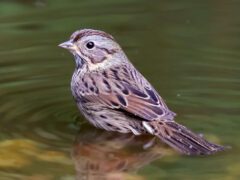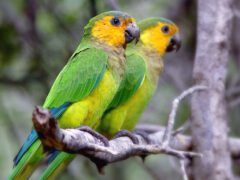Common Tern Photo Gallery
Breeding adult (hirundo/tibetana)
Medium-sized tern with deeply forked tail. Breeding adults across most of the range have a gray belly, full black cap, and reddish bill. The upper side of the outer primaries is dark gray, creating a dark wingtip.
© Michiel Oversteegen / Macaulay LibraryAruba, July 28, 2019Breeding adult (hirundo/tibetana)
Medium-sized tern with a slender, straight bill. Tail is about the same length as the folded wings. Breeding adults in the widespread "hirundo/tibetana" subspecies group (which occurs in the Americas, Europe, Africa, and parts of Asia) usually have a grayish chest, a bright red, black-tipped bill, and red legs.
© Gale VerHague / Macaulay LibraryNew York, July 16, 2019Adult and juveniles
Breeding adults have a neat black cap and red bill with black tip. In this image, note the long crossed wingtips (above) about the same length as the forked tail (below). Nests in the open on beaches.
© Benjamin Clock / Macaulay LibraryMaine, July 18, 2012Not all videos have soundBreeding adult (longipennis)
Breeding adults in the "longipennis" subspecies group have a black bill and black (or dark brown) legs. This subspecies group breeds in northeastern Asia and occurs as a vagrant in western Alaska.
© Steven McBride / Macaulay LibraryNew South Wales, April 12, 2019Nonbreeding adult (hirundo/tibetana)
Nonbreeding adults lose the front portion of their black cap, showing a white forehead and black hindcrown. Legs and bill turn blackish as winter progresses. Note tail does not extend beyond wingtips at rest.
© S. K. Jones / Macaulay LibraryFlorida, August 30, 2017Immature (hirundo/tibetana)
Immatures and nonbreeding adults have a distinctive black bar on the leading edge of the wing, known as a carpal bar. Tail does not extend beyond wingtips.
© Jody Wells / Macaulay LibraryBritish Columbia, September 25, 2017Immature (longipennis)
Immature birds in the "longipennis" group have a black bill, white forehead, dark carpal bar on the wing, and dark legs.
© Anonymous / Macaulay LibraryNew South Wales, January 05, 2021Juvenile (hirundo/tibetana)
Juveniles have a faint brownish wash to the back and a partial black cap that extends to the crown. They also have a dark leading edge to the wing, or carpal bar.
© Linda Ankerstjerne Olsen / Macaulay LibraryConnecticut, July 29, 2018Nonbreeding adult (hirundo/tibetana)
Flies with wingtips swept back with rowing wingbeats. Nonbreeding adults have a white forehead and black on the crown and behind the eye, with blackish bill. Note the black wedge on the upper side of the wingtips.
© County Lister Brendan / Macaulay LibraryMichigan, September 09, 2017Breeding adult (hirundo/tibetana)
Medium-sized tern with deeply forked tail. Outer primaries form a dark wedge on the upper side of the wingtips. Wings are slender, swept back, and narrow at the base.
© Doug Hitchcox / Macaulay LibraryMaine, July 12, 2017Immature (hirundo/tibetana)
Immature birds lack the long tail feathers of breeding adults and appear darker in flight, with more black in the wings and tail.
© Max McCarthy / Macaulay LibraryNew Jersey, August 05, 2018Nonbreeding adult (longipennis)
Nonbreeding "longipennis" adults develop a white forehead but are otherwise similar to breeding adults. This subspecies group spends the nonbreeding season in the eastern Indian Ocean, Southeast Asia, and along the Australian coast.
© Steven McBride / Macaulay LibraryNew South Wales, May 13, 2020Immature (longipennis)
Terns fly gracefully with rowing wingbeats over open waters, diving down to pick fish from or just below the water's surface.
© Steven McBride / Macaulay LibraryNew South Wales, May 13, 2020Habitat
Occurs along shorelines, barrier islands, and estuaries, as well as on large inland lakes. In coastal areas, typically less numerous in brackish areas than along the ocean shore.
© Keith Lowe / Macaulay LibraryNova Scotia, July 13, 2017Compare with Similar Species
Click on an image to compare
Species in This Family
Gulls, Terns, and Skimmers(Order: Charadriiformes, Family: Laridae)
More to Read
Don't miss a thing! Join our email list
The Cornell Lab will send you updates about birds,
birding, and opportunities to help bird conservation.











































